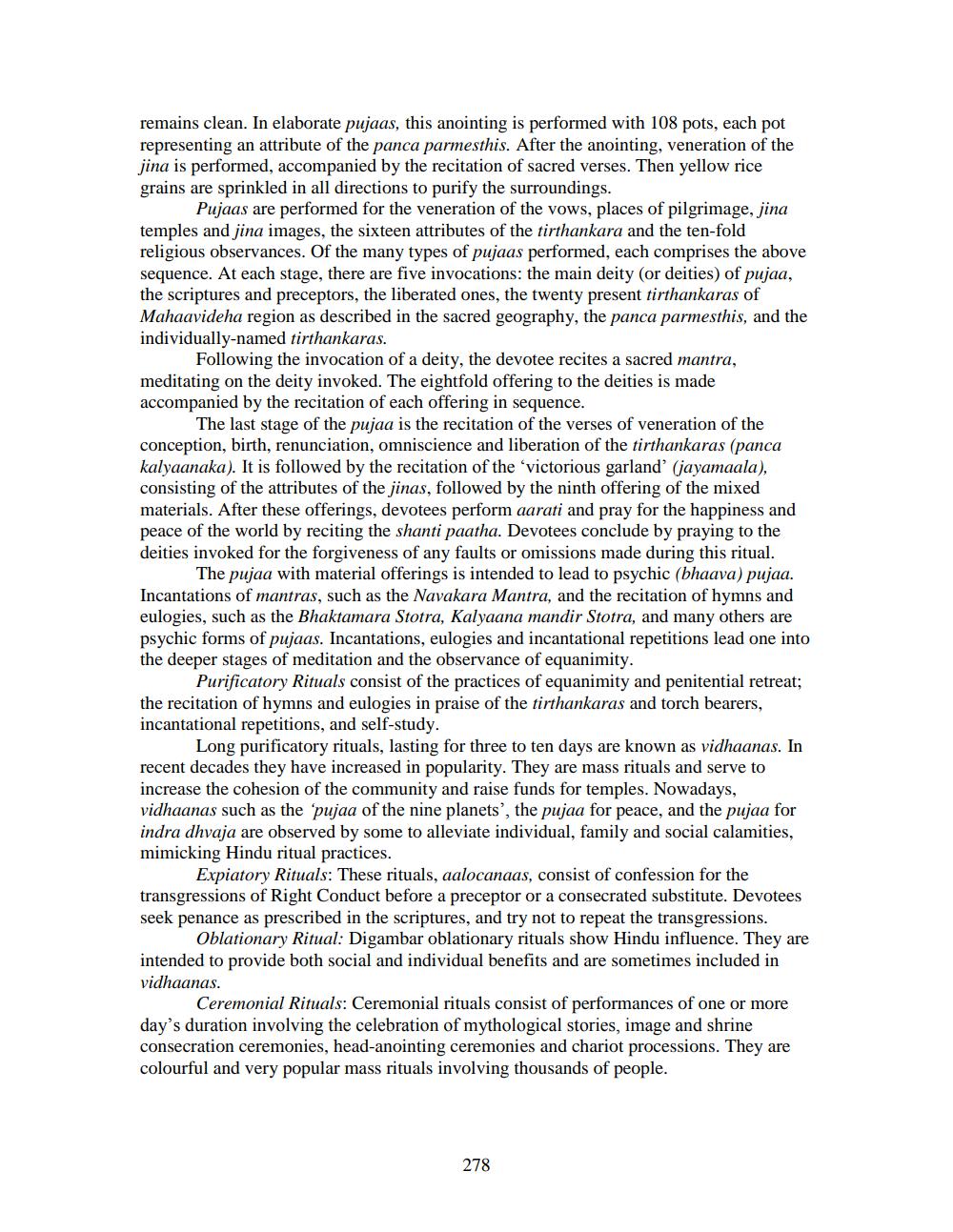________________
remains clean. In elaborate pujaas, this anointing is performed with 108 pots, each pot representing an attribute of the panca parmesthis. After the anointing, veneration of the jina is performed, accompanied by the recitation of sacred verses. Then yellow rice grains are sprinkled in all directions to purify the surroundings.
Pujaas are performed for the veneration of the vows, places of pilgrimage, jina temples and jina images, the sixteen attributes of the tirthankara and the ten-fold religious observances. Of the many types of pujaas performed, each comprises the above sequence. At each stage, there are five invocations: the main deity (or deities) of pujaa, the scriptures and preceptors, the liberated ones, the twenty present tirthankaras of Mahaavideha region as described in the sacred geography, the panca parmesthis, and the individually-named tirthankaras.
Following the invocation of a deity, the devotee recites a sacred mantra, meditating on the deity invoked. The eightfold offering to the deities is made accompanied by the recitation of each offering in sequence.
The last stage of the pujaa is the recitation of the verses of veneration of the conception, birth, renunciation, omniscience and liberation of the tirthankaras (panca kalyaanaka). It is followed by the recitation of the 'victorious garland' (jayamaala), consisting of the attributes of the jinas, followed by the ninth offering of the mixed materials. After these offerings, devotees perform aarati and pray for the happiness and peace of the world by reciting the shanti paatha. Devotees conclude by praying to the deities invoked for the forgiveness of any faults or omissions made during this ritual.
The pujaa with material offerings is intended to lead to psychic (bhaava) pujaa. Incantations of mantras, such as the Navakara Mantra, and the recitation of hymns and eulogies, such as the Bhaktamara Stotra, Kalyaana mandir Stotra, and many others are psychic forms of pujaas. Incantations, eulogies and incantational repetitions lead one into the deeper stages of meditation and the observance of equanimity.
Purificatory Rituals consist of the practices of equanimity and penitential retreat; the recitation of hymns and eulogies in praise of the tirthankaras and torch bearers, incantational repetitions, and self-study.
Long purificatory rituals, lasting for three to ten days are known as vidhaanas. In recent decades they have increased in popularity. They are mass rituals and serve to increase the cohesion of the community and raise funds for temples. Nowadays, vidhaanas such as the 'pujaa of the nine planets', the pujaa for peace, and the pujaa for indra dhvaja are observed by some to alleviate individual, family and social calamities, mimicking Hindu ritual practices.
Expiatory Rituals: These rituals, aalocanaas, consist of confession for the transgressions of Right Conduct before a preceptor or a consecrated substitute. Devotees seek penance as prescribed in the scriptures, and try not to repeat the transgressions.
Oblationary Ritual: Digambar oblationary rituals show Hindu influence. They are intended to provide both social and individual benefits and are sometimes included in vidhaanas.
Ceremonial Rituals: Ceremonial rituals consist of performances of one or more day's duration involving the celebration of mythological stories, image and shrine consecration ceremonies, head-anointing ceremonies and chariot processions. They are colourful and very popular mass rituals involving thousands of people.
278




